-
Hello guest! Are you an Apistogramma enthusiast? If so we invite you to join our community and see what it has to offer. Our site is specifically designed for you and it's a great place for Apisto enthusiasts to meet online. Once you join you'll be able to post messages, upload pictures of your fish and tanks and have a great time with other Apisto enthusiasts. Sign up today!
New to Apistogrammers and need advice!
- Thread starter chrislisk
- Start date
I wouldn't mix them with apistogramma - not clue how they would actually work out but it just feels wrong. Also not sure how the betta would respond if an apisto signaled it - naturally it wouldn't understand the apisto signals so who knows what would happen.
Apistogramma are NOT community fish. And to be honest there are no "community fish" at all. Every community tank is a foul compromise at the expense of at least one species in the tank. Biotope communities are IMO the closest you can get to cohabitation without the fish being incompatible. And even then...
The following is all under the premise that there is only a pair or a single Apisto and breeding is not a goal.
Fish that definitely work with Apistogramma in tanks with a footprint of 60x30cm:
- Tetras: smaller Hyphessobrycon species, Pristella, Paracheirodon, Tucanoichthys (Note: obligate blackwater species)
- Pencilfish: Basically all Nannostomus work, sometimes they need some more space than the Apistos (e.g. N. beckfordi and N. eques)
- Loricarid catfish: Otocinclus, Parotocinclus, Otothyropsis (Note: All of these are feeding specialists, the tank has to be well seasoned. At least 6 months since setup, better a full year! They need significant amounts of aufwuchs.)
Fish that work with Apistogramma in bigger tanksizes (120x40cm footprint and bigger):
- Tetras: Additionally bigger Hyphessobrycon species like Bleeding Hearts. Also Gymnocorymbus ternetzi (blackskirt tetras) and Petitella bleheri (Rummynose tetras).
- Hatchetfish: They become interesting in that tanksize. As they stick to the surface they rarely interact with Apistos at all.
- Corydoras: Best only with male Apistogramma. Breeding Apistogramma with Corydoras in the same tank rarely works out together.
- Loricarid catfish: Panaqolus sometimes work, Ancistrus not so much. The latter are a bit too boisterous. Especially nocturnal species are out, as diurnal cichlids will get stressed easily by them. Twig catfish and smaller lizard catfish work well, but also a good sized tank.
- Depending on the definitive tank size bigger peaceful cichlids like Mesonauta might be interesting.
About other fish:
What has proven again and again to be rather a bad idea (stressing one species or the other, or simply a bad match alltogether):
- livebearers (stressfactor, especially bigger boisterous species like Platies or Mollies)
- any bottomdwellers that are unable to understand Apisto body language: Loaches, many catfish, gobies
- many Labyrinthfish unless the tank is well planted and high enough.
- any other territorial species with similar lifestyle (includes african dwarf cichlids)
About the structure in the tank:
I see far too many unbroken lines of sight. Ignore your sense of aesthetics, the lines of sight on the fishes usual swimming level have to be broken. I can see through to the back between the driftwood, that's not gonna cut it.
Also, maybe replace some of the fake plants with thickets of twigs and branches. And the rest with real plants. As plastic can't "grow in" it only takes up space for effective structure.
The following is all under the premise that there is only a pair or a single Apisto and breeding is not a goal.
Fish that definitely work with Apistogramma in tanks with a footprint of 60x30cm:
- Tetras: smaller Hyphessobrycon species, Pristella, Paracheirodon, Tucanoichthys (Note: obligate blackwater species)
- Pencilfish: Basically all Nannostomus work, sometimes they need some more space than the Apistos (e.g. N. beckfordi and N. eques)
- Loricarid catfish: Otocinclus, Parotocinclus, Otothyropsis (Note: All of these are feeding specialists, the tank has to be well seasoned. At least 6 months since setup, better a full year! They need significant amounts of aufwuchs.)
Fish that work with Apistogramma in bigger tanksizes (120x40cm footprint and bigger):
- Tetras: Additionally bigger Hyphessobrycon species like Bleeding Hearts. Also Gymnocorymbus ternetzi (blackskirt tetras) and Petitella bleheri (Rummynose tetras).
- Hatchetfish: They become interesting in that tanksize. As they stick to the surface they rarely interact with Apistos at all.
- Corydoras: Best only with male Apistogramma. Breeding Apistogramma with Corydoras in the same tank rarely works out together.
- Loricarid catfish: Panaqolus sometimes work, Ancistrus not so much. The latter are a bit too boisterous. Especially nocturnal species are out, as diurnal cichlids will get stressed easily by them. Twig catfish and smaller lizard catfish work well, but also a good sized tank.
- Depending on the definitive tank size bigger peaceful cichlids like Mesonauta might be interesting.
About other fish:
What has proven again and again to be rather a bad idea (stressing one species or the other, or simply a bad match alltogether):
- livebearers (stressfactor, especially bigger boisterous species like Platies or Mollies)
- any bottomdwellers that are unable to understand Apisto body language: Loaches, many catfish, gobies
- many Labyrinthfish unless the tank is well planted and high enough.
- any other territorial species with similar lifestyle (includes african dwarf cichlids)
About the structure in the tank:
I see far too many unbroken lines of sight. Ignore your sense of aesthetics, the lines of sight on the fishes usual swimming level have to be broken. I can see through to the back between the driftwood, that's not gonna cut it.
Also, maybe replace some of the fake plants with thickets of twigs and branches. And the rest with real plants. As plastic can't "grow in" it only takes up space for effective structure.
- Messages
- 11,574
- Location
- Denver, Colorado, U.S.A.
After reading all of the posts I am not sure if you want a community tank or a breeding tank. In small tank it is virtually impossible to have both. If you want a community tank, forget having pairs or more of apistos. It almost never works out well for any of the fish in the tank. Just have one apisto and add fish you like, and are compatible, around it. If you want to possibly breed apistos then pick a pair/trio you like, decorate the tank properly (in your recent photo the tank is much too open) and add some dither fish that inhabit the upper level and not fry predators.
Thats a fair comment. I have always breed milawis for a few years and that’s now stopped as I’ve gone male only hap and peacock so this is a new project for me, that was originally designed to just let my baby royal pleco grow out a little.
having taken everything on board I have desired to godown the breeding route and will just retain the trio of cockatoo and see how they go, I believe these are the least forgiving of apistos to keep.
I have changed the tank around a lot today given all the threads I have read and advice I’ve been given.
New wood and a complete change based on black water tanks I have looked at online.
I know I need more plants so will add them over the next weeks.




having taken everything on board I have desired to godown the breeding route and will just retain the trio of cockatoo and see how they go, I believe these are the least forgiving of apistos to keep.
I have changed the tank around a lot today given all the threads I have read and advice I’ve been given.
New wood and a complete change based on black water tanks I have looked at online.
I know I need more plants so will add them over the next weeks.
If you do want some motion at the top again i would recommend kubtai rasbora; they are not native to south america but they are small (smaller than ember tetra) stay near the top and provide a lot of motion - just a suggestion. Also having some plants float on top helps a bit to diffuse the light - hornworth, frogbit italia val (with long leaves) can all work. None of these things are required just something to consider.
So I thought I would update you as to where I am with this little tank. So I’ve been looking at Blackwater bio tank set ups as I understand that is where my Apistogramma caucatoides come from and most similar to their natural habitat.
you have helped shape this tank so far so thought you would want to see it progressing. Any advice would be much appreciated. I’ve added different wood and all the plants now are live and real. I’ve gone with easy growers as I have sand substrate. Amazon swords, crypto and Java fern etc. I ha e also added some dried old oak leaves that I found at my local park, boiled them and let them drop in.
I have decided to stay with the trio of cockatoos and will be adding a group of maybe 10 red ember tetra.
water still clearing so bit cloudy



you have helped shape this tank so far so thought you would want to see it progressing. Any advice would be much appreciated. I’ve added different wood and all the plants now are live and real. I’ve gone with easy growers as I have sand substrate. Amazon swords, crypto and Java fern etc. I ha e also added some dried old oak leaves that I found at my local park, boiled them and let them drop in.
I have decided to stay with the trio of cockatoos and will be adding a group of maybe 10 red ember tetra.
water still clearing so bit cloudy
You're getting there. Like it.
Try to fill the leftover open viewing angles. Like shove some of the rocks under the roots where you can look through under them. Don't even have to be under them properly, just a bit closer.
Just as a hint: A. cacatuoides are not blackwater species, but clear- and sometimes whitewater. Meaning: While the decoration can be almost the same, the water doesn't have to be that dark, soft and acidic. It looks almost perfect the way it is. Wait until the plants have grown in.
Try to fill the leftover open viewing angles. Like shove some of the rocks under the roots where you can look through under them. Don't even have to be under them properly, just a bit closer.
Just as a hint: A. cacatuoides are not blackwater species, but clear- and sometimes whitewater. Meaning: While the decoration can be almost the same, the water doesn't have to be that dark, soft and acidic. It looks almost perfect the way it is. Wait until the plants have grown in.
No they are not. To be fare ive only added leaves to give them foliage on the floor. I am
Not going to actively lower the PH. I thought it looked good and more in keeping with there habitat. Bearing in mind I have seen people keep these in sponge Bob square pants houses and pink gravel.
Not going to actively lower the PH. I thought it looked good and more in keeping with there habitat. Bearing in mind I have seen people keep these in sponge Bob square pants houses and pink gravel.
They are indeed not.I could be mistaken but i don't believe cockatoo are blackwater fishes...
Leaf litter is never a bad idea and these few oak leaves won't have any influence on pH anyway.No they are not. To be fare ive only added leaves to give them foliage on the floor. I am
Not going to actively lower the PH. I thought it looked good and more in keeping with there habitat. Bearing in mind I have seen people keep these in sponge Bob square pants houses and pink gravel.
Clearwater would be still extremely soft, but only with a medium pH around 6 instead of 5 or even 4, relatively high TDS of around 50-100 and EC at about 100-200.
You are luckily thousands of miles away from a sponge bob aquarium.
So I’ve added my dither fish today…….after much deliberation I’ve added a group of 12 neon green tetra. They look really good, the green flash they have looks great with everything. I’m thinking I’ll add another 3/4 to make the group a bit bigger. When they shoal together they look amazing, especially in the slightly darker water with low light.
Don't get used to this. They will disperse when fully acclimated.When they shoal together they look amazing, especially in the slightly darker water with low light.
Yep. The only tetras that actually school (not shoal) without being new or stressed are rummynose and red-eye tetras, which I would keep in numbers of at least 40 in tanks of at least 150cm length. In smaller tanks rummynose also disperse after a while but still swim around a lot, producing a kind of hectical atmosphere, while most other tetras get into certain "parking positions" in display territories and barely leave those except for feeding.
20 green neons is the maximum I would put in your tank size.
20 green neons is the maximum I would put in your tank size.
They are indeed not.I could be mistaken but i don't believe cockatoo are blackwater fishes...
Well... that doesn't mean no A. (cf.) cacatuoides forms/locations live in black water, and thrive!
In a tributary stream to the Rio Pacaya (Rio Ucayali-drainage, Peru), which has very black water, and looked like this:
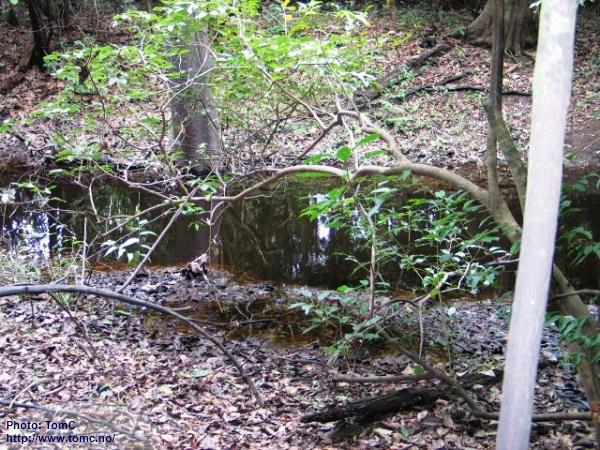
I collected A. (cf.) cacatuoides:
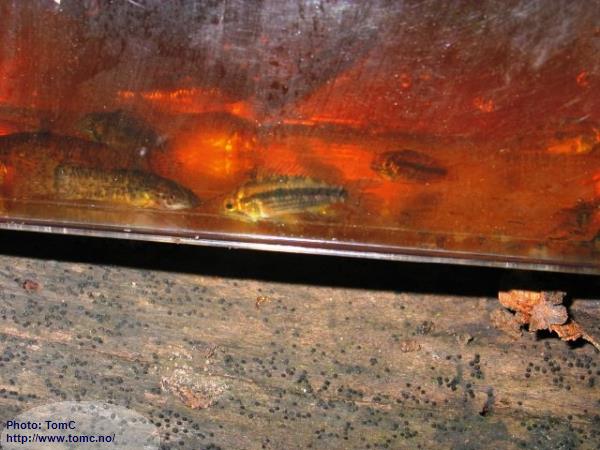
which looked like this, back home in a tank:
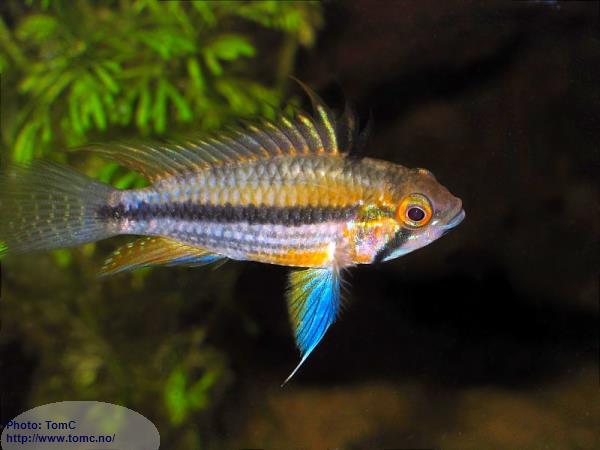
and in this blackwater stream in the Rio Nanay-drainage (Peru):
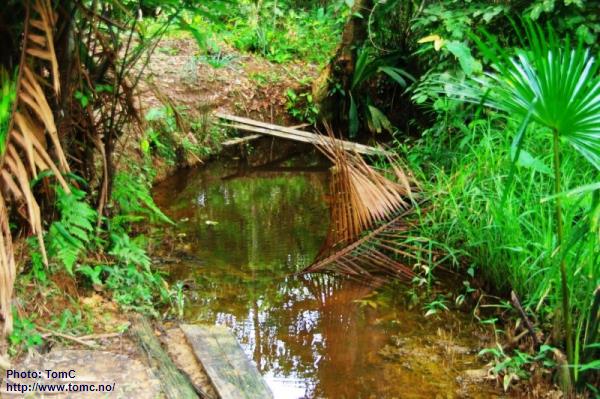
I also collected beautiful A. (cf.) cacatuoides:
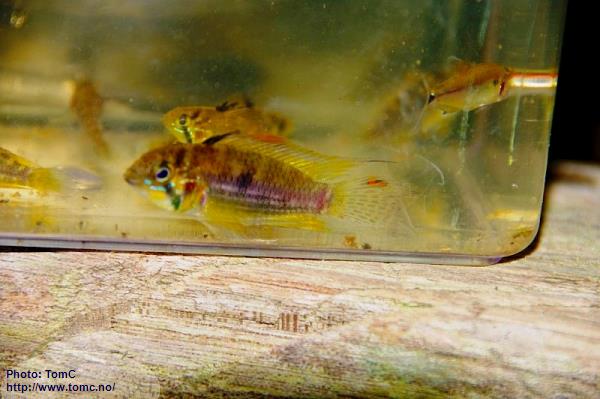
And remember: a little humic substances, like fulvic acids, prevents whole body sodium loss and stimulates
branchial calcium uptake capacity, in very soft (and calcium-poor) water.
What does that mean for domestic strains of the species, though?Well... that doesn't mean no A. (cf.) cacatuoides forms/locations live in black water, and thrive!
In a tributary stream to the Rio Pacaya (Rio Ucayali-drainage, Peru), which has very black water, and looked like this:

I collected A. (cf.) cacatuoides:

which looked like this, back home in a tank:

and in this blackwater stream in the Rio Nanay-drainage (Peru):

I also collected beautiful A. (cf.) cacatuoides:

And remember: a little humic substances, like fulvic acids, prevents whole body sodium loss and stimulates
branchial calcium uptake capacity, in very soft (and calcium-poor) water.
Similar threads
- Replies
- 13
- Views
- 577
Forum statistics
Latest profile posts
I'm looking for quality apistogrammas, can anyone recommend a good seller specialized in apistogrammas who ships in Europe? Thanks